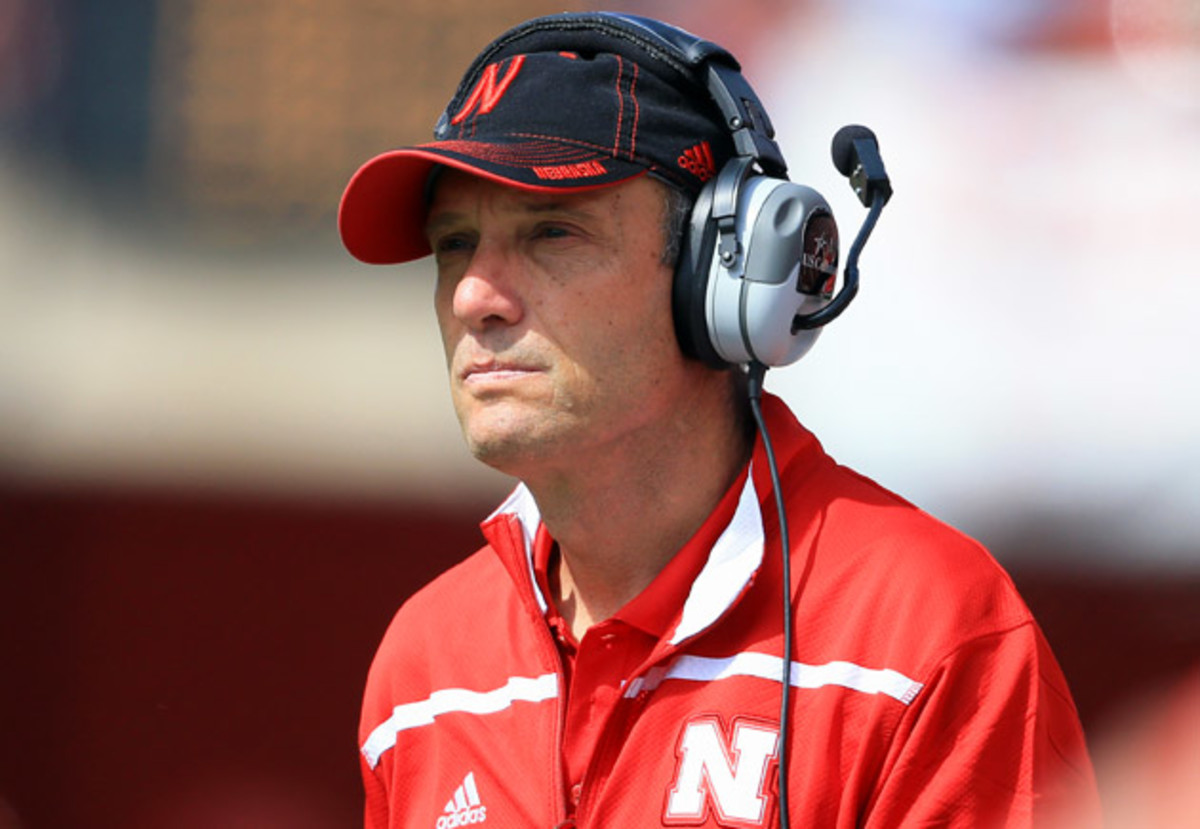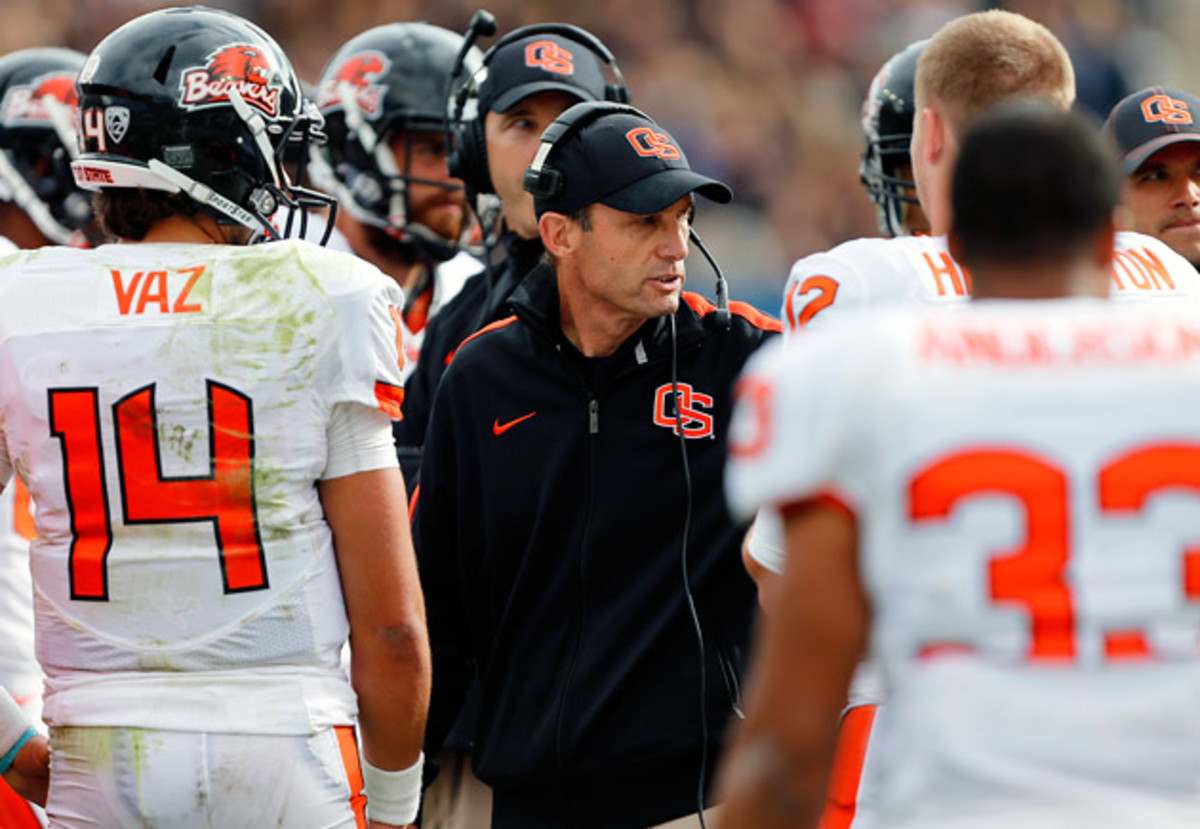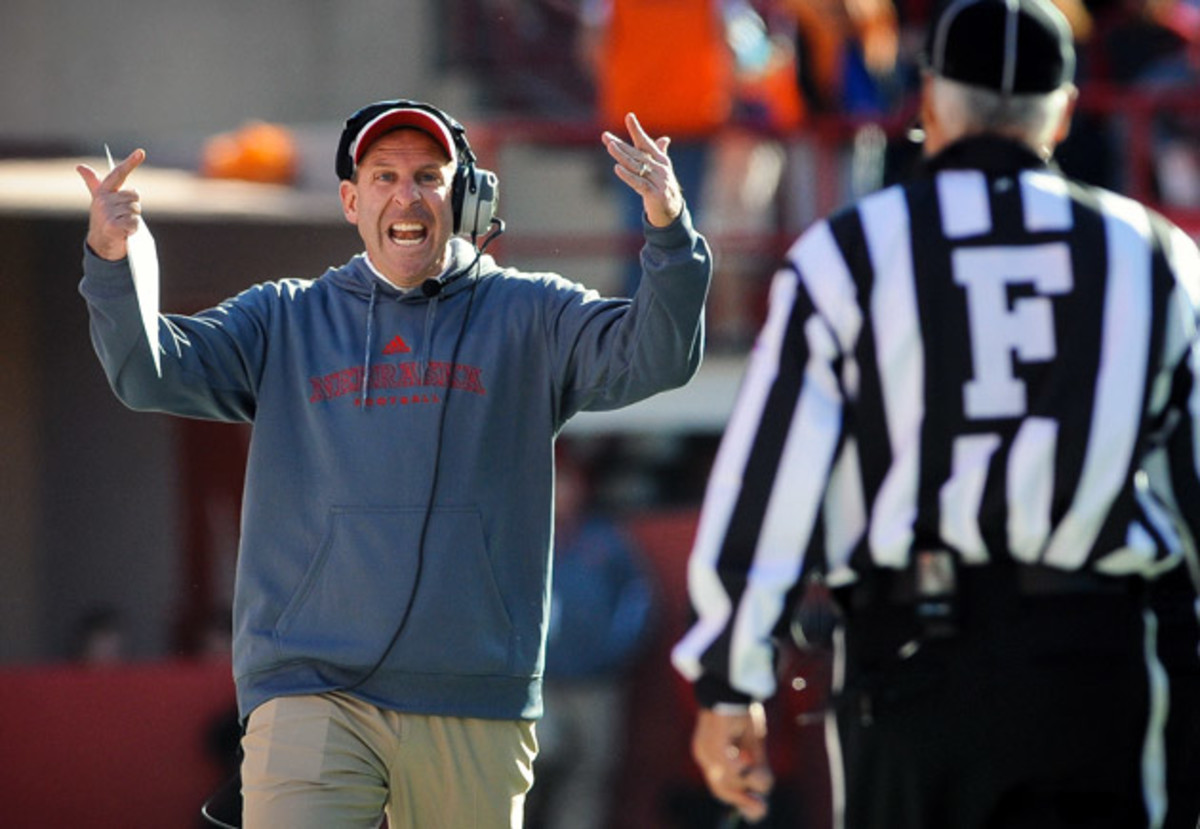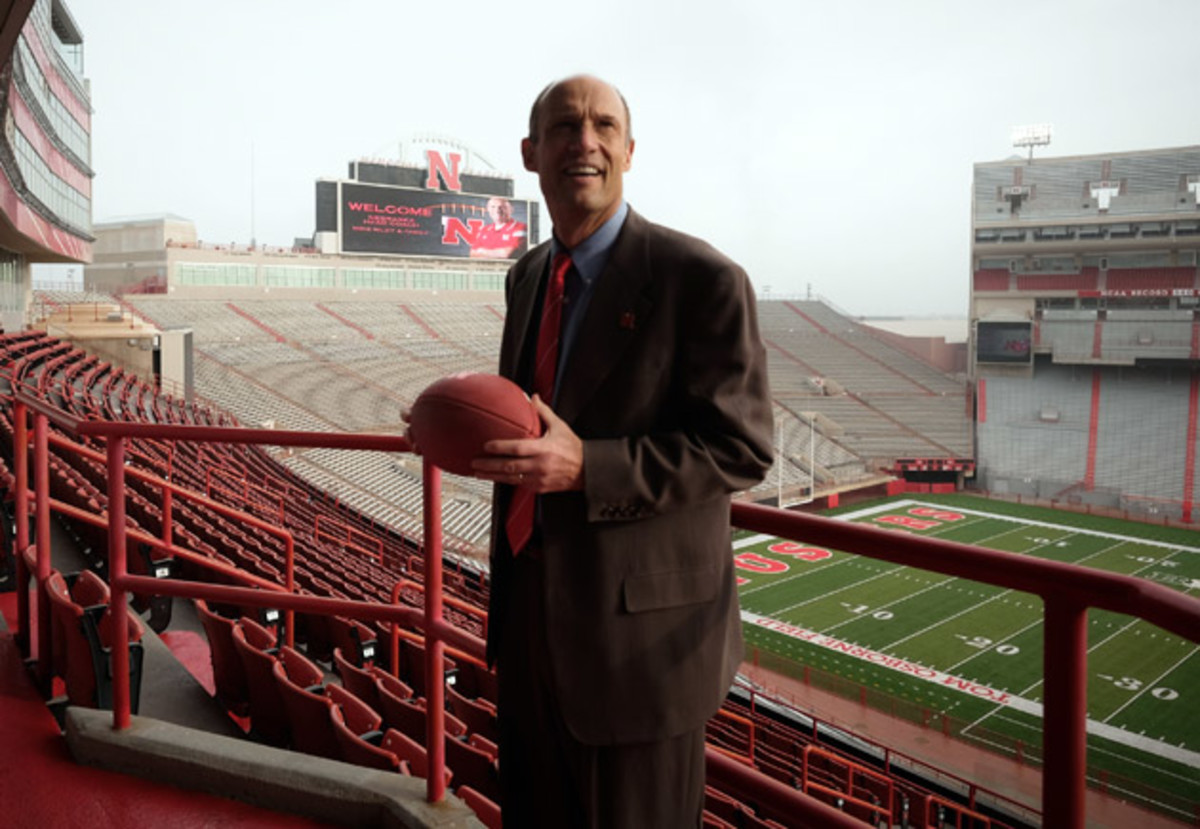The Riley Factor: Mike Riley and the new-look state of Nebraska football

LINCOLN, Neb.—Mike Riley insists he does not need a bodyguard. Five months into the job, Nebraska’s new football coach says he can handle the autograph seekers and well wishers, those who stand five feet from him, nudge their neighbor and whisper, “That’s the Huskers coach!” He loves meeting fans and thinks it’s “neat” kids ask to take pictures with him. If he tires of the attention, he doesn’t show it.
In December Nebraska stunned the college football world by hiring the 61-year-old Riley away from Oregon State, where he had spent the last 12 years. If fans are anxious about their coach’s age or the start of a new era, they haven’t shown it: Riley has quickly become the most popular person in town, with the Cornhuskers’ faithful dressed in shirts with slogans like, “Riled up for Riley,” “The Riley Factor” and “I Like Mike.” Riley jokes that the Nebraska football coach might be the most recognizable face in Lincoln, excluding the mayor. In reality, it includes the mayor. Riley is viewed as a figurehead of the state, though he will likely never get comfortable with his rock-star status.
Can Mike Riley deliver on Nebraska's high expectations? #DearAndy
When Riley goes out in the community, his support staff tries to form a makeshift box around him, with four people posted at corners to keep rabid fans at bay. Director of player personnel Ryan Gunderson sheepishly admits it doesn’t really work. At a home basketball game shortly after Riley’s hiring, offensive coordinator Danny Langsdorf abandoned his boss in a throng of fans, worried Riley might never get out of the arena. “I get stopped because the respect for this position and this program is special,” Riley says. “They love their school. Football is obviously the focal point, but what you find here is that every game is an event. All the energy in the state is poured into this program. Couple that with the fact that it’s been historically a great place and, well …”
Well, you get life in Lincoln, where the Huskers can brag about having some of the best facilities and resources in the country, and the tradition to deserve them, too. There’s no element of buying their way on to the scene. Nebraska was once the program everyone aspired to be, with five national championships, 110 All-Americas and loads of feel-good, walk-on-to-starter stories, a vital component in a state that takes pride in its blue-collar mentality.
Recreating Camelot—and specifically the undefeated 1995 team that still enchants fans across the country—isn’t likely to happen. But Nebraska expects to win conference championships and compete for College Football Playoff berths. That’s why the Huskers fired Bo Pelini on Dec. 1, 2014, despite his winning at least nine games in each of seven seasons at the helm. A volatile relationship with athletic director Shawn Eichorst and soured fan support played a role in his ouster as well.
Riley’s transition will be daunting, but the man considered by his peers to be the nicest guy in college football is the perfect personality fit in the heartland. Michael Rose-Ivey, a junior linebacker, describes him like this: “He’s definitely an optimist. The glass isn’t just half full, it’s ¾ full. All the time.”
The question this fall, and over the next five years of Riley’s contract, will be how to find the right balance of folksy Riley rubbing off on Nebraska, and the tradition-rich Huskers rubbing off on their new coach.
*****

Forever at Oregon State, the narrative with Riley was he did more with less. In two stints spanning 14 years in Corvallis, he turned the Beavers from Pac-12 doormats into Rose Bowl contenders, using a pro-style system to churn out NFL prospects. He coached two Biletnikoff Award winners (Mike Hass in 2005 and Brandin Cooks in ’13). He refused to use Corvallis’s lack of an airport (the closest is 45 minutes away and in the same town as the Beavers’ archrival) or sparkling facilities (the operations building hasn’t received a serious facelift since 1990) as excuses for performance. A graduate of Corvallis High—his dad, Bud, was a Beavers assistant from ’65-72—Riley sold recruits on the family-friendly atmosphere of a small town.
But over the past seven seasons a major shift transpired. Defensive coordinator Mark Banker, who worked with Riley for 12 years at Oregon State and followed him to Nebraska, considers 2009 the tipping point: The Beavers played for a shot at the Rose Bowl for the second straight year, losing 37-33 to Oregon in the Civil War. The spiral started soon after. “Our success from 2006-09, we never capitalized on it,” Banker says, pointing to a pause in stadium renovation and the lack of facility upgrades. “Unfortunately this recruiting process is about things, in a lot of cases.”
Outside activity contributed, too. The Pac-12, long considered a conference of stepping-stone jobs, became home to a crop of talented, proven head coaches who decided the West Coast could be a destination. Riley became the longest-tenured coach by a lot, with the additions of Rich Rodriguez (Arizona), Todd Graham (Arizona State), Jim Mora (UCLA) and Mike Leach (Washington State). The Ducks, Oregon State’s rival to the south, had already broken into college football’s upper echelon after playing for the 2010 national title. In Riley’s last five years in Corvallis the Beavers went 29-34, falling short of bowl eligibility three times. Fans grumbled it was time for Riley to go. In some ways, he became a victim of his own success.
Riley acknowledges Oregon State had been “on a down cycle” during his last two years at the school, but insists that was not his motivation for leaving.
New coaching staff aims to prove Oregon State can compete with best
“We had lived a whole life of a roller coaster there,” Riley says. “Even within a season, we’d start bad and people would grumble and then we’d get better and it would all be O.K. Right at the end, before I made a decision [to go to Nebraska], I knew, I told myself, ‘I can fight through anything.’”
Before he could, Nebraska and Eichorst came calling. Riley had no previous connection to the Huskers—he never even visited campus before taking the job—but Eichorst had heard good things about Riley from Paul Chryst, the current Wisconsin coach and a former Riley assistant. A longtime believer in the principles of “The Energy Bus,” a business book by Jon Gordon, Eichorst was set on hiring someone who bubbled positivity. The down-to-earth Riley is the opposite of the prickly Pelini, keeping with the theme of ADs typically going a completely different direction, personality-wise, from their previous head coach.
Eichorst called Riley on the morning of Monday, Dec. 1, to gauge his interest. They met secretly on Tuesday in San Francisco, where Riley was scheduled to recruit. Two days later, Nebraska announced its new hire with a tweet no one saw coming. Even Tom Osborne, the iconic former Huskers coach who served as the AD for six years and remains plugged in, was shocked. “The perception of Mike is that he was pretty much a permanent fixture at Oregon State,” Osborne says. “I thought he’d be there the rest of his coaching career.”
But the opportunity for “one more adventure” intrigued Riley and his wife of 34 years, Dee. Riley’s name surfaced each time USC went looking for a new coach (he was a Trojans assistant from 1993-96), and he was a candidate at South Carolina before it hired Steve Spurrier in 2004. (Eichorst was a Gamecocks assistant athletic director during that search.) Riley understands the irony of a coach his age diving headfirst into a new job where championships are the barometer, instead of starting a retreat toward retirement.
“I’ve thought about that, that I’ve jumped into the busiest part of my life,” he says, laughing. “At times it’s been hard for me to wrap my arms around why [I did this].”
*****
[pagebreak]

If he had less than most at Oregon State, Riley has a ridiculous amount more at Nebraska. In the Osborne Athletic Complex in Lincoln, nearly 90,000 square feet is devoted solely to football; in Corvallis it was 52,000. The Beavers didn’t have the necessary roster depth to stage actual spring games; this spring the Huskers had more than 120 athletes at each practice, allowing coaches to split guys into four teams and get multiple reps. Riley estimates when freshmen arrive on campus the team will open fall camp with a staggering 150 players. During Riley’s tenure at Oregon State, about 5,000 fans typically showed up for what could generously be described as a scrimmage. Nebraska’s spring game on April 11 drew 76,881 fans and 193 credentialed media members.
“People here think that we have the greatest fans in college football,” Riley said following the spring game. “And I think they're out to prove it all the time. It's a pretty interesting thing to be a part of.”
Wildly different, too. Consider that at Oregon State, planning and construction for an updated operations building stalled about seven years ago. The Beavers have one of the smallest locker rooms in the Power Five, a card that can be played against them in recruiting wars. Nebraska, by contrast, has what feels like unlimited resources. And Riley has access to all of them.
Ready to fly again? Oregon reloading this spring after losing the title game
The Huskers have a huge indoor practice facility for football, but there’s another indoor facility on campus that’s part of the student rec center. Riley toured it in the spring and remarked offhand that it needed to be re-turfed. Eichorst’s reply: “Just tell me what you want to do.” It’s scheduled to be finished this summer, and will be used to give Nebraska added practice space this fall.
In Lincoln Riley has reunited with more than just Banker, who came of age in an era that revered Nebraska football and didn’t hesitate to go there when the chance arose. “I knew what the N stood for,” Banker says. “Excellence.” Riley has also hired longtime offensive coordinator Langsdorf, who helped tutor signal-callers at Oregon State and spent last season as the New York Giants quarterbacks coach, and running backs coach Reggie Davis, who was with Riley three years in Corvallis before joining the San Francisco 49ers. Couple that with five assistants brought over from the Beavers, plus the numerous support staff members—and add in all the ex-Oregon State stars who have visited Nebraska and watched film with Huskers, such as quarterback Sean Mannion—and it feels like Riley has recreated what he had in his Oregon State heyday. That includes sometimes-goofy staff antics: The day before the spring game, Langsdorf rode, in rather wobbly fashion, a bike from the offensive wing to the defensive wing while two players in the lobby exchanged bewildered looks.
Much like Riley is adapting to his environment, everyone is slowly adjusting to his relaxed vibe. What other major college football coach would accept a ride back to his hotel from a fan he didn’t know on a frigid night, as Riley did earlier this winter? It’s different, players say. But they like it.
“He got really mad one day at practice and yelled, “Jiminy Christmas!’” Rose-Ivey says. “And I thought, ‘Well, this is totally different than what we just had.’”
*****

What Nebraska had was a leader short on patience, known more for his blow-ups with fans, administrators and the media than he was for program-changing wins. Pelini’s meltdowns became public fodder, due mostly to leaked audio. He dared the administration to fire him, told fans the team was better off without them, verbally attacked local columnists and responded to criticism from legendary quarterback Tommie Frazier by stating, “We don’t need him.” Players say outsiders painted a much more lethal portrait of Pelini than is accurate, and most did not support the decision to fire him. Regardless of if Pelini was kinder than often portrayed, though, it’s clear his act wore thin in Lincoln.
There’s an argument to be made Pelini took the us-against-the-world mentality too far, picking fights with administrators and making it clear that this was his program. With Riley in charge, Eichorst ducks into coaches’ meetings and mills about chatting with recruits. “The approach and core values at Nebraska—hard work, respect, humbleness, loyalty, trust—those beliefs are Mike’s beliefs,” Eichorst says. “His zest and zeal for life … it’s been uplifting for our whole department.”
With QB race undecided, Notre Dame should shape identity around the run
It’s also infectious. Sophomore receiver De’Mornay Pierson-El says Riley exhibits a child-like joy around the office, a feeling he finds contagious. “It’s like when mom would take you to the toy store and tell you, ‘O.K., you can have anything you want,’ and you’re so excited you’re shaking and can’t figure out what to do. You pick up one thing and mom says, ‘Yes!’ and you’re excited and then you pick up something else and she says ‘Yes!’ to that, too.
“Right now coach Riley is looking around Nebraska, making a master plan to play with every toy.”
He understands his responsibilities, of course. Upon getting to campus Riley told players that things would be “different, not necessarily better” with a new staff, and showed a lot of respect for Pelini. That type of acknowledgment helped prevent any transfers. There’s also the specter of escaping the long shadow cast by Osborne’s success—a 255–49–3 record, 13 conference titles and three national championships—as each of his successors (Frank Solich, Bill Callahan and Pelini) has failed to bring Nebraska back to the perch fans believe is its rightful place in the college football hierarchy. The Huskers have lost at least three games in every season since 2001, the year of their last major bowl, a blowout loss to Miami in the national championship.
But it’s more than just a fall from dominance. Nebraska hasn’t won a conference title since 1999, an unacceptable drought for a program with top-notch resources and prestige. There are no pro teams and only one football-playing university in the state; if the Huskers lose, there’s nothing to distract from the disappointment.
Osborne doesn’t necessarily agree with the idea that his legend looms large in Lincoln, and hopes no coach feels mounted pressure because of his presence. “I’ve been gone for a quite a long time,” says Osborne, 78. “Some people growing up [now] don’t even know when I was there.”
That speaks perfectly to both a different era and the attitude of a state hungry for trophies. It doesn’t matter that some people dressed in red weren’t around during the glory years. This is Nebraska. You don’t have to be a veteran fan to recognize this program is supposed to win.
*****

Riley knows all the optimism regarding his hiring and likeable personality will evaporate if the Huskers don’t win, and soon. “In life, some people and places have higher standards,” Rose-Ivey says. “In the college football realm, this is that place.” Eichorst expects Nebraska to compete “at the highest level,” and says Riley will be judged “just like coaches in the past,” adding that he likes what he has seen so far. Often incorrectly labeled soft because of his friendly demeanor, Riley welcomes those standards. Still, he knows his coaching reputation will come under fire if things go wrong. “I understand the expectations,” he says. “They grew at Oregon State, too, and that’s O.K. This is new and fun and energizing to me.”
Director of player personnel Gunderson, who arrived as a quarterback at Oregon State in 2003 and hasn’t left Riley’s side since, is quick to point out the challenges at Nebraska. Lincoln isn’t a drive-by visit for prospects outside the state, and the staff must find a way to tell “the story of this place” to teenagers who weren’t alive in the dominant era. The Huskers play in a league with the defending national champs, and Michigan hired Jim Harbaugh, one of Riley’s longtime friends. The Big Ten is set for a resurgence of sorts. It’s important Nebraska isn’t left behind.
Riley’s pro-style scheme and 4-3 defense figure to work well in a conference with fewer spread attacks than the Pac-12. He’ll incorporate some zone read into the offense, partly because likely starting quarterback Tommy Armstrong can generate yardage with his legs. Riley’s system has long been home to a powerful runner, but the Huskers graduated their top playmaker in tailback Ameer Abdullah. Pierson-El, a receiver built in the same mold as ex-Oregon State All-Americas James Rodgers and Cooks, looks to be a star in the making with Riley’s use of the fly sweep.
Charlie Strong ready for next step in rebirth at Texas; Punt, Pass & Pork
Former Texas coach Mack Brown, one of the Riley’s closest friends, believes Riley’s style will translate well in Lincoln. “As a person he has this solid, quiet toughness that can run a program and manage what needs to be done but still smile and reach out to fans,” Brown says. “As a coach, I’ve seen him have 2,000-yard rushers one year then 2,000-yard passers the next year. He’s tremendously bright as an offensive mind. It’s a home run for both [Riley and Nebraska].”
Players are still smarting from the way Pelini’s firing unfolded, annoyed by Eichorst’s decision to inform them of the coaching change via email. But they’ve embraced this new, weird culture and are finding hard-nosed Nebraska meshes well with down-home Riley. He has kept some customs (awarding black shirts to the starting defense) while introducing some of his own (cheering wins with a few good, old-fashioned hip-hip-hoorays). Occasionally, the Huskers even have some fun with the new guy.
In mid-March a fight broke out in practice and a seething Riley hollered, “We’re not gonna practice things that are going to lose us games!” He threatened to make players run until they puked if they acted up again. On April Fools’ Day the team planned a fake brawl, with guys running from both practice fields to converge on the scrum. Riley stared at the pile in disbelief, wondering how he was going to separate so many flying fists, when players started laughing and ‘fessed up. And at the conclusion of the spring game, players soaked Riley with a Gatorade shower.
Asked afterward about dousing their new coach with a sports drink, Rose-Ivey smiled mischievously.
“A little initiation,” he said, invoking both team pranks. “We figured we’d welcome him to the club.”
date | opponent |
|---|---|
Sept. 5 | BYU |
Sept. 12 | South Alabama |
Sept. 19 | at Miami |
Sept. 26 | Southern Miss |
Oct. 3 | at Illinois |
Oct. 10 | Wisconsin |
Oct. 17 | at Minnesota |
Oct. 24 | Northwestern |
Oct. 31 | at Purdue |
Nov. 7 | Michigan State |
Nov. 14 | at Rutgers |
Nov. 27 | Iowa |
